One aspect of Rock and roll is all about being loud, proud, and in your face. No musician embodies that mentality more than, the Motor City Madman, Ted Nugent. He has been turning his amps up to eleven and pumping his high-feedback, heavily distorted tones through hollow-body guitars for almost 60 years!
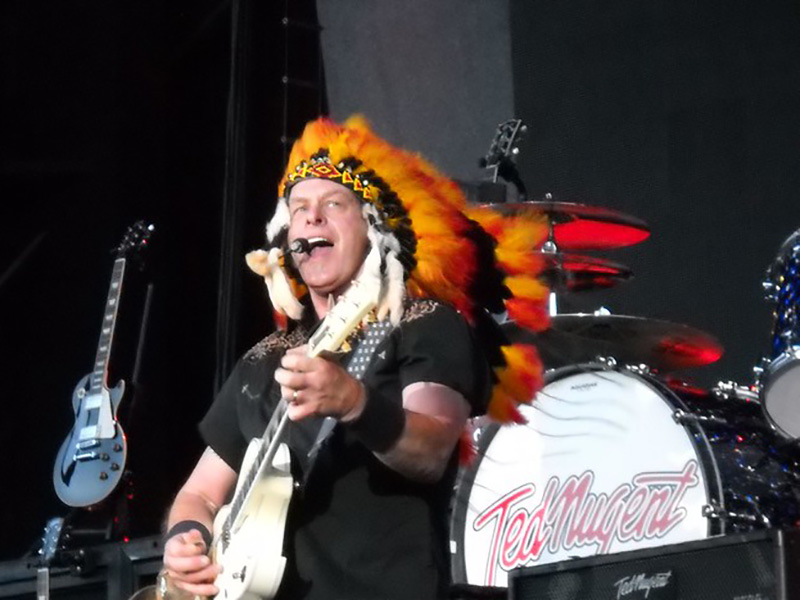
Having a long and illustrious career, creating some of the most iconic guitar riffs of all time, including “Cat Scratch Fever” and “Stranglehold.” He was even named the greatest guitarist to ever come out of Detroit! Ted Nugent started playing music at an early age. He got his first guitar when he was about five or six, sometime around 1953. It was a “horrible” cheap acoustic guitar—as he describes it—but he learned to emulate the greats including James Brown, Wayne Cochran, Chuck Berry, Keith Richards, and Lonnie Mack, to name a few. He was always drawn to high-energy performers and loved the soulful sound of the blues. From that point on, Ted has been responsible for the evolution and translation of a blues foundation into the phenomenon that Hard Rock is known to be.
What Kind of Guitar Does Ted Nugent Play?
Ted Nugent plays Gibson Byrdland guitars. Other than his Gibson Byrdland, The Nuge also frequently uses Gibson Les Paul and PRS models on stage. However, Nugent has never necessarily been considered a collector. Over his career, he has found a few guitars he likes and tends to stick with them.
See the full list of Ted Nugent guitars and gear below.
Gibson Byrdland
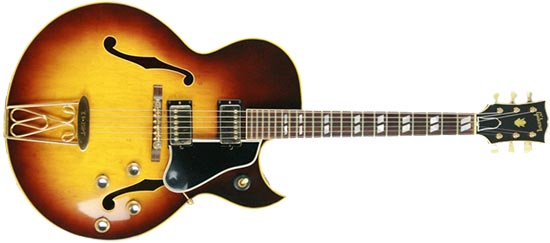
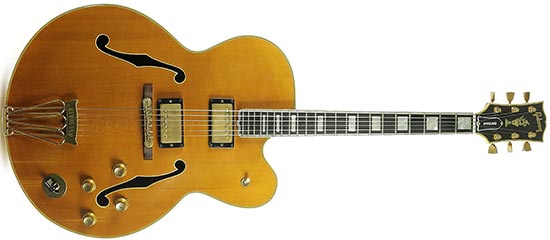
| Finish | Ebony/Alpine/Sunburst/Natural |
| Years Used | 1966 to Present |
No other guitar has been “fondled” (as he so colorfully puts it) by Ted Nugent as much as the Gibson Byrdland. It has been his go-to guitar for the entirety of his career and is responsible for some of the most iconic riffs in Rock and Roll history, including “Cat Scratch Fever” and “Stranglehold.”
Ted Nugent didn’t find the Byrdland; it found him. Way back in 1961 or ’62 when Nugent was only 13 years old, he went to a Billy Lee and the Rivieras concert (later renamed to The Detroit Wheels) and witnessed the power of the Byrdland for the first time in the hands of Jim McCarty.
When Jim McCarty started playing his incredible, soulful, bluesy solos, the young Nuge just couldn’t believe the sound. The hollow-body guitar wanted to feedback so badly and created “scary noises” that gave the notes new dimensions of sound. It was nothing like he had ever heard before. Because he was so young and inexperienced, Ted Nugent didn’t quite know what was really going on to create that sound, but he knew he loved it. He had to have one.
Just a few years later in 1966, Ted Nugent finally bought his very own Byrdland. It was a brand-new 1966 Gibson Byrdland with a Florentine Blond finish, and it immediately became his primary player. He couldn’t get over the insane “snarl” he could get from the hollow body with the spruce archtop.
Not only could the Byrdland produce heavy, fuzzy tones, but it was also one of the most versatile guitars that Ted Nugent had ever played. Depending on where you put the settings, you could create the sound and tone of almost any guitar.
Although the Byrdland was originally developed to be a jazz guitar, Nugent humorously says he “fixed” that. While most hard rock guitarists shy away from hollow-body guitars because of the crazy feedback, Ted Nugent embraced it. As he put in an interview, “It’s not about managing the feedback; it’s about succumbing to it.”
Nugent actually loves how easily the Byrdland produces feedback and uses it to create his unique tones. If you see him moving around on stage, he’s not dancing (well, most of the time). Ted Nugent strategically positions himself in relation to his amps to get just the right amount of feedback to create the tone he’s looking for. According to Nugent, the Byrdland makes guitarists play differently, which is why his style is so unique. They don’t call him the Motor City Madman for nothing!
Over the years, Ted Nugent has collected between 18 and 26 Gibson Byrdlands (the number seems to change depending on when you ask) in a variety of finishes. He typically brings at least four or five on every tour. Here are a few of the most iconic:
1966 Florentine Blond Gibson Byrdland – This was Nugent’s original Byrdland he bought in 1966. It was the primary guitar used to record some of the most iconic Ted Nugent songs, including “Stranglehold” and “Cat Scratch Fever.” Nugent donated this guitar to the Hard Rock Café in London but admits he wishes he could get it back. It was his prized possession—guitar-wise, at least.
1961-1964 Ebony Gibson Byrdland – One of Nugent’s primary Byrdlands is a vintage Ebony model. He’s not quite sure on the year, but at different times Nugent himself said it was a 1964, while his guitar tech called it a 1961 model. Either way, the black Byrdland has been a mainstay on Nugent’s guitar rig for decades. You can see it in action in this video of “Cat Scratch Fever” from back in the 1970s. Over decades of use, the finish has cracked and checkered, but it only makes the guitar look even better! Nugent sweats a lot on stage and actually destroyed the original pickups. He replaced them with Burstbucker 2 pickups. This is probably Nugent’s favorite Byrdland besides his original ’66.
“Great White Buffalo” Alpine Gibson Byrdland – The Great White Buffalo is an Alpine white Byrdland with a few custom touches. On the shoulder, Ted Nugent’s name is inlaid in gold lettering, and two large arrows cross over the entire back of the guitar. The rest of the guitar is stock, with a few headstock repairs after being completely broken off after a show. You can see this guitar in action on the song “Great White Buffalo” (of course), while Nugent sports a Native American headdress.
Despite his three most iconic guitars, Nugent says he can’t pick just one Byrdland as his absolute “favorite.” They all sound so good and have their own special purposes. Whenever Uncle Ted gets a new Byrdland, he numbers the guitar with a wood-burning tool. He also adds his initials, TN. While many purists think it destroys the guitars, Nugent thinks it gives them a special uniqueness.
Most of Nugent’s Byrdlands are vintage models with a sharp single cutaway. Whenever Ted Nugent takes the stage, you’re almost guaranteed to see a Gibson Byrdland or two.
Gibson Stars and Stripes Custom Les Paul

| Finish | American Flag |
| Years Used | 2008 to Present |
It’s no secret that Ted Nugent is one of the proudest Americans out there. He’s known for being rather outspoken when it comes to his political beliefs and his love for the U.S.A. To show his love for his country, he got a custom-made Gibson Les Paul with an American Flag finish.
Ted Nugent had been using Gibson Les Pauls for a few years, but around the mid-2000s, he commissioned his Gibson Stars and Stripes Custom Les Paul. Almost instantly, it became one of his primary players on stage. In fact, from about 2008 on, Nugent used his Stars and Stripes Custom on stage more than any other guitar—even his Byrdlands!
According to Nugent himself through a personal Facebook post, his Stars and Stripes LP features dual Gibson humbucker pickups that are raised to the point of almost touching the strings. They have to be close to get all that screaming rock and roll goodness! It also features a smaller neck than most Les Paul models to fit Nugent’s smaller hands.
Other upgrades include a Gretsch strap pin on the pickup selector to make it easier to use and witch hat tone and volume knobs for “maximum sweaty Teddy traction.” All in all, it’s a bonafide, patriotic, rock and roll machine built for the Motor City Madman himself.
You can see the Stars and Stripes Custom Les Paul in action in almost any Ted Nugent performance from the mid-2000s on. Check out this powerful performance of “Never Stop Believing” from 2016. There is quite a bit of ranting before the song starts, but the awesome solo more than makes up for it!
The Stars and Stripes Custom isn’t the only Les Paul in Uncle Ted’s collection. He also had two prized vintage Les Pauls, sunburst 1959 and 1958 models, that frequented the stage in the late ‘90s and early 2000s.
In 2020, Ted Nugent decided it was time to thin out his collection and put his ’58 and ’59 LPs up for auction. He still has the Stars and Stripes custom, and the two continue to rock stages all over the world. This is easily one of the most legendary Ted Nugent guitars of all time.
PRS Ted Nugent Custom
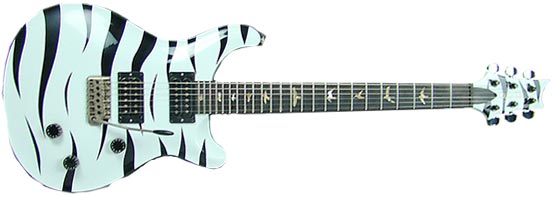
| Finish | Custom Stripes |
| Years Used | 1985 to Present |
Around 1985, a young Paul Reed Smith was looking to sell some of his custom guitars to some popular rockers to make a name for himself. He didn’t have a factory or really a business yet, just a few well-built guitars and a dream. At the time, there was no one bigger than Ted Nugent.
Of course, PRS wasn’t as well-known back then as it is now. He couldn’t just waltz backstage and talk to The Nuge. So, as the dedicated businessman he is, Smith pulled a stunt. He threw a few of his custom creations under his arm, ran to the venue where Ted was playing, and yelled to the guys at the door, “Oh man, I’m late! Where’s the stage?”
Seeing a man running up to the door of a Ted Nugent concert with a bunch of guitars, security let him right in. When he made it backstage, Smith talked to a few of the roadies, showed them his guitars, and they agreed to let him meet Ted Nugent.
Ted Nugent loved the guitars so much that they were instantly added to his arsenal. He believes that the player shouldn’t adapt to the guitar. It’s important to take the time to shop around and find the right one that feels the best. His custom PRSs did just that. He was one of the first major artists to endorse PRS guitars.
According to Ted Nugent, the PRS guitars had a certain capability that other guitars didn’t. He could do things with them that he couldn’t do with any other type of guitar, even his beloved Byrdlands. The intro arpeggios on “Little Miss Dangerous” according to the man himself, were only possible because Ted has his PRS.
Nugent’s PRS models are all custom made for him by Paul Reed Smith himself. They all have dual humbuckers, tremolo tailpieces, 24-fret necks, and custom striped finishes. You can usually find Nugent on stage with either his zebra-striped or tiger-striped PRS.
Ted Nugent’s zebra-striped PRS was one of his primary players when he joined the supergroup Damn Yankees with Tommy Shaw from Styx, Jack Blades from Night Ranger, and a then-unknown drummer Michael Cartellone who would later join Lynyrd Skynyrd. You can see Nugent’s zebra PRS in the music video for “High Enough” from 1990.
Fender Duo-Sonic

| Finish | Unspecified |
| Years Used | 1959 to 1965 |
Although Ted Nugent started playing guitar when he was about five or six (somewhere around 1953), he didn’t get his first “good” guitar until about 1959. When he realized he was serious about playing music, Nugent decided he needed a proper instrument.
The young Ted picked up a few odd jobs to scrounge some money—including a paper route, selling nightcrawlers, washing cars, raking lawns, and shoveling snow. He finally scraped up enough cash to pay off his own brand-new Fender Duo Sonic.
The Fender Duo-Sonic is a guitar made for players who didn’t want a Tele or a Strat. It features two single-coil pickups to deliver that legendary Fender tone but with a neck built for easy playability and a three-way switch in the horn. It’s a great instrument for innovative players, like Nugent.
Ted wanted the Duo-Sonic because, at the time, he was into The Ventures, and it kind of looked like one of their guitars. However, there’s not much information about his original Fender Duo-Sonic, but it was the guitar he used to land his first big gig. In 1962, he won the Battle of the Bands with his first act the Lourdes and got to open for the Beau Brummels and the Supremes at one of the newest clubs in Detroit. It was a big deal that helped launch his music career.
Shortly after the big break, The Nuge decided that he didn’t really want to be like The Ventures and moved into a harder rock scene that he would eventually help to create. His Fender Duo-Sonic served him well, but it was time to move on to bigger and better things. By 1965, it had been replaced first by an Epiphone Casino before setting his sight onto his beloved 1966 Gibson Byrdland.
Epiphone Casino
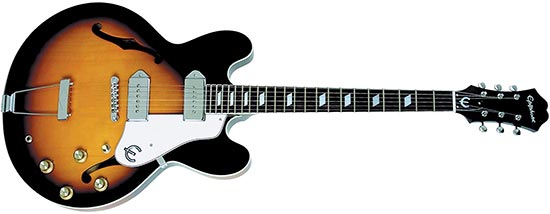
| Finish | 1965 to 1966 |
| Years Used | Vintage Sunburst |
Following his The Ventures phase, Ted Nugent went through a brief Beatles phase. Back in the early 1960s, they were the “hard rock” of the time! As any Beatles fan can attest, there’s no cooler guitar than the Epiphone Casino.
Around 1965, Ted Nugent traded in his The Ventures-esk Fender Duo Sonic and a few hundred dollars for a Vintage Sunburst Epiphone Casino, just like Paul and John used to play.
The Epiphone Casino is a hollow-body guitar, which is a lot different than the solid-body Duo-Sonic Ted Nugent was playing. Not only was did it get more feedback from the amp, but it also featured dual humbuckers instead of the Fender single coils.
While his Epi was a step in the right direction, it didn’t quite take Nugent to where he wanted to be. After a very short run together, Ted Nugent traded his mostly new Casino for his beloved 1966 Gibson Byrdland. The rest is history.
Timetable Showing Each Guitar Ted Nugent Has Played at Each Point of His Career
| Make | Model | Color/Finish | Years |
|---|---|---|---|
| Fender | Duo-Sonic | Unspecified | 1959 to 1965 |
| Gibson | Byrdland | Ebony/Alpine/Sunburst/Natural | 1966 to Present |
| PRS | Ted Nugent Custom | Custom Stripes | 1985 to Present |
| Gibson | Stars and Stripes Custom Les Paul | American Flag | 2008 to Present |
Ted Nugent Amplifier Overview
It takes a lot of amps to create such a loud, heavy, rock and roll sound. Amps have filled the stage for many of Ted Nugent’s over 6,000 concerts. He originally started with Fenders and over time switched over to Peavy and Kustom amps. Here’s a rundown of The Nuge’s amps.
Peavy 6505+
Ted Nugent’s go-to amp head is the Peavy 6505+. When you need straight-up raw power, this is the amp for you! It boasts 120-watts of tube-driven insanity that will blow audiences away in even the largest stadiums. The 6505+ is great for producing gainy “liquid inferno,” as it says on the product page.
On stage, Nugent’s 6505+ heads are pushing multiple Peavy 6505 412 240-watt 4×12 cabinets for even more insane rock power. When you absolutely, positively need to be heard (perhaps even in outer space), this is the amp setup you need.
Surprisingly, this setup is actually a bit quieter than what he used to playback in the 1970s and ‘80s. His past rig was so loud that he became deaf in one ear. He “quieted” his amp set up so he can actually hear his band and prevent damage to his one good ear. He uses only a “couple” 120-watt heads and 240-watt cabinets, and they’re not even turned to full volume. He admits this isn’t a musical choice; it’s out of necessity to save his hearing.
Peavy 5150
Back in the late ‘80s and early ‘90s, Ted Nugent started to make a change away from his standard Fender amps for something with a more powerful tone. Well, there’s nothing more “in your face” than a Peavy.
Ted Nugent’s first Peavy experience was with the 5150 tube head. This amp was originally designed as a signature model for Eddie Van Halen. It was 120-watts of pure rock power. Nugent immediately fell in love and has used Peavy amps ever since. He used the Peavy 5150 during his time with the Damn Yankees.
The Peavy 5150 was eventually discontinued when Van Halen and Peavy parted ways in 2004. While the EVH brand continued to produce its own 5150 amps, the 6505 models took their place in Peavy’s lineup.
Kustom Quad 100 DFX
In later shows, Ted Nugent has been seen on stage rocking with Kustom Quad 100 DFX heads and cabinets mixed in with his Peavy amps. The Kustom Quad 100 DFX is a 100-watt tube head with an incredible lead gain boost, which Nugent always loves! To add a little more flair, Ted Nugent’s Kustom head has customized zebra-striped paneling.
The powerful 100-watt head pushes matching Kustom Quad 100 DFX 2×12 combo amps for even more rock and roll power. It’s not hard to get feedback from his hollow-body Byrdlands with this setup!
Fender Twin Reverb
In his early days, Ted Nugent used almost exclusively Fender amplifiers. Back in the mid-1970s and into the ‘80s, The Nuge would blow away stadiums with several Fender Twin amps lining his side of the stage.
The Fender Twin Reverb is a go-to for everyone from clean jazz and blues players to heavier rock and alternative powerhouses. It features 85-watts of tube-driven combo perfection. It’s a classic for a reason!
Back in the day, Ted Nugent would have eight of these powerhouses stacked on stage, delivering unmatched volume to stadiums all over the world. According to Uncle Ted himself, this setup was almost too loud even for him. As he so colorfully describes, “Birds would fly by at 100 yards and poof into nothing because the sound was so loud.”
After years of using eight 85-watt amps on stage, Ted Nugent became deaf in his left ear and had to revert to a slightly smaller rig (if you count 120-watt Peavys as “smaller”).
You can see this impressive Fender Twin setup in this live version of “Stranglehold” from 1978.
Fender Bassman
Back in the late 1950s when Ted Nugent got his first “good” guitar, the Fender Duo-Sonic, he played it through a little 45-watt Fender Bassman amp. It was a smaller tube-driven combo amp that could get loud and distorted enough to make any budding musician happy. After all, Ted wasn’t playing stadiums just yet.
The Fender Bassman had such a good tone that Ted Nugent stuck with Fender exclusively for decades. Even when he needed more power as his shows got bigger (and louder), he upgraded to Fender Twin amps—just a lot more of them.
Ted Nugent Pedals and Effects Overview
Although he’s considered one of the more innovative guitar players when it comes to tone, Ted Nugent doesn’t actually use many pedals or effects. He prefers to let the guitars and the amps create his tone, specifically by using feedback. To him, you just can’t beat the pure sound of a guitar plugged directly into an amp.
Here are the very few effects that have been on Nugent’s pedalboard over the years.
MXR Phase 90
Whenever Ted Nugent is in a particularly fun mood, he’ll step on his orange MXR Phase 90 to add a little uniqueness to his tone. He doesn’t use it often, but he says he hits it “for kicks and giggles” occasionally.
The MXR Phase 90 is one of the most popular phaser pedals on the market. It has been used by guitar legends like Eddie Van Halen, Josh Homme, and Dave Grohl, just to name a few. It gives players a smooth, watery effect that adds a little extra flavor to both lead and rhythm parts.
Dunlop Cry Baby Wah
Every guitarist needs a little wah power every now and then. When Uncle Ted feels like rocking a wah solo, he uses the Dunlop Cry Baby Wah. The Cry Baby has been a standard for many legendary guitarists over the years. Although he doesn’t use it often, he still keeps the Cry Baby on his pedalboard, just in case, the mood feels just right.
Boss DD-3 digital delay
The Boss DD-3 digital delay is a standard delay pedal that gives guitarists from budding beginners to experienced rockers the echoey sound they’re looking for.
Of course, Ted Nugent doesn’t really use an echoey tone. He prefers straight-up, in-your-face rock and roll. Although he has a Boss DD-3 on his pedalboard, The Nuge admits that he hasn’t stepped on it in years. It’s just a pretty face.
Boss CH-1 Super Chorus
Similar to his other effects pedals, Ted Nugent also has a Boss CH-1 Super Chorus on his pedalboard, but he doesn’t use it often. It’s there just to add a little flavor to his tone from time to time.
The CH-1 is another standard for guitarists all over the world. It adds that little “shimmer” to lead and rhythm parts that really make them stand out. Of course, Ted Nugent doesn’t need much of a shimmer to stand out. He does that plenty well on his own!
Guitar Cables
Although it might not be considered an effect, Ted Nugent attributes much of his outstanding tone to his guitar cables. While most musicians use wireless packs to make moving around the stage a bit easier—especially those who perform high-energy shows like Ted Nugent—The Nuge still uses traditional cables to connect his guitar to the amps.
Although he doesn’t specify the brand, in a rig rundown, Ted Nugent says he uses “big fat guitar cables” to keep his gain-driven tone pure from the guitar to the amps and out into the audience’s ears. According to him, there’s no better way to create a pure rock and roll tone than simply plugging a great guitar directly into a great amp. The simpler and more direct, the better. Ted Nugent has never been one to beat around the bush.
Wrap Up
Although he played in smaller bands throughout his youth, Ted Nugent helped form his first real band in 1965, when he was 17, called the Amboy Dukes. Despite Nugent’s anti-drug and alcohol beliefs, the Amboy Dukes were considered a psychedelic rock band. The band enjoyed moderate success with a few mainstream albums and even got to play with legends like Joni Mitchell, Buddy Guy, Jimi Hendrix, and BB King. In 1982, Ted Nugent helped form the supergroup Damn Yankees with Styx guitarist/vocalist Tommy Shaw, Night Ranger bassist/vocalist Jack Blades, and drummer Michael Cartellone. The Damn Yankees played together for eight years until 1989 and saw major success. Their self-titled album went double platinum in the United States!
After his stint with Damn Yankees, Nugent returned to the solo spotlight and continues to rock stages all over the world with his high-octane, blues-driven rock and roll.
In 1975, following the Amboy Dukes disbandment, Nugent started his remarkable solo career. He wrote several major hits, including “Cat Scratch Fever” and “Stranglehold”, tunes that would propel him into legendary status. In the late ’70 and well into the ’80s, there was hardly a bigger name in the Rock and Roll scene than Ted Nugent!
In addition to his musical career, Ted Nugent is also an outspoken activist for the second amendment. He has written several books and appeared on TV shows related to hunting and shooting.
Whether or not you agree with his politics, there’s no doubt that Ted Nugent is one of the best guitarists to ever come out of Detroit, furthermore, his skill set is balanced between his singer-songwriter status and guitar-slinging. Even in his 70s, Uncle Ted still manages to give high-energy performances that audiences won’t soon forget—perhaps for better or worse. He’s no stranger to shooing flaming arrows on stage, sometimes at one of his guitars! If you’re looking for straightforward, feedback-ridden, in-your-face rock music, it’s hard to beat the Motor City Madman, Ted Nugent.

My name is Chris and I’ve had a passion for music and guitars for as long as I can remember. I started this website with some of my friends who are musicians, music teachers, gear heads, and music enthusiasts so we could provide high-quality guitar and music-related content.
I’ve been playing guitar since I was 13 years old and am an avid collector. Amps, pedals, guitars, bass, drums, microphones, studio, and recording gear, I love it all.
I was born and raised in Western Pennsylvania. My background is in Electrical Engineering, earning a Bachelor’s degree from Youngstown State University. With my engineering experience, I’ve developed as a designer of guitar amplifiers and effects. A true passion of mine, I’ve designed, built, and repaired a wide range of guitar amps and electronics. Here at the Guitar Lobby, our aim is to share our passion for Music and gear with the rest of the music community.

The Amps that Ted used on stage from the mid 70s to the 80s were Fender Super Twins which were rated at 180 watts and incredibly loud. Ted would have 4 to 6 Super Twins on stage
Hi
Im amazed to see Ted using a archtop guitar for rock .
It sounds great
He has one Kustom DFX 100, but also another Kustom Combo on stage just a few feet away….its smaller and looks like it may be a DFX 65? Can anyone confirm?